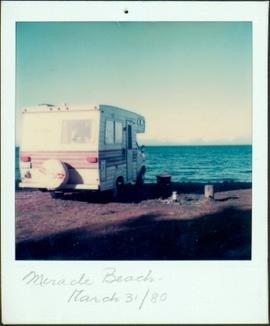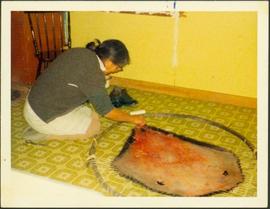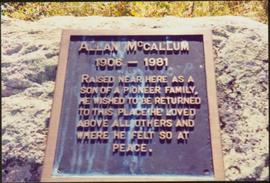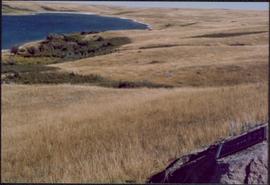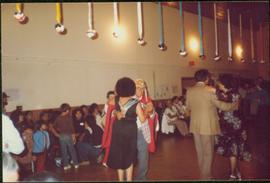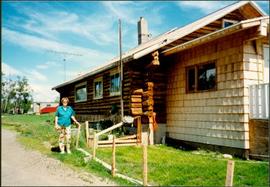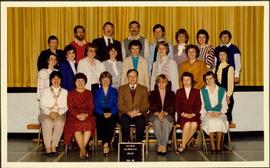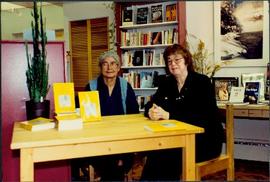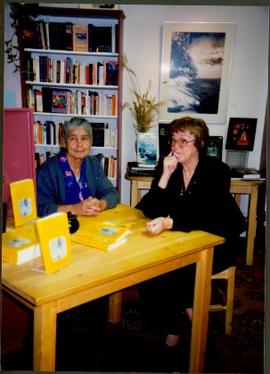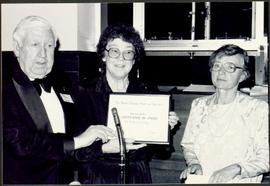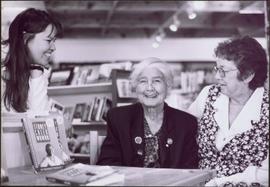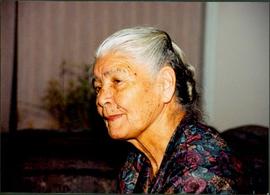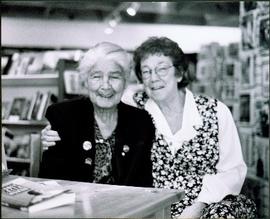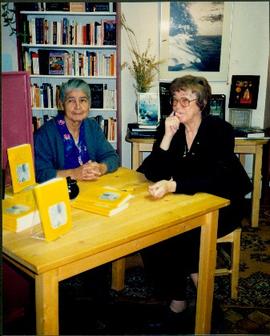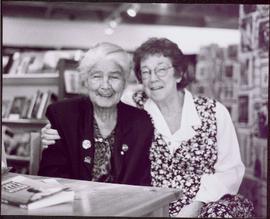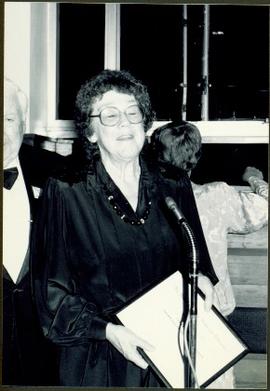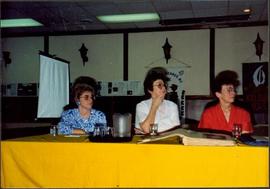Water and opposite shore visible in background. Handwritten annotation on verso: "Miracle Beach - March 31/80".
File consists of Bridget Moran's Social Work notebook for Kelly Road School (Sept. 1979 - June 1980).
Photograph depicts Mary John kneeling on floor while stretching hide. Chair and shoes in background.
File consists of Bridget Moran's Social Work notebook for Kelly Road School (Sept. 1980 - June 1981).
Photograph depicts grave marker which reads "ALLAN McCALLUM / 1906 - 1981 / RAISED NEAR HERE AS A SON OF A PIONEER FAMILY, HE WISHED TO BE RETURNED TO THIS PLACE HE LOVED ABOVE ALL OTHERS AND WHERE HE FELT SO AT PEACE."
Audio recording is of an interview that Bridget Moran conducts with a Mrs. Thompson held in Success, Saskatchewan. Mrs. Thompson talks about municipal politics in the rural town of Success, Saskatchewan when Jimmie (her husband?) was on the Council. Most of the interview relates to Mrs. Thompson’s account of the marital and domestic life Alfie (Guy?) who was another town councilor and known as a local poet.
Audiocassette Summary
Side 1
00’05” Moran asks Mrs. Thompson about the time that Jimmie (her husband?) was on the Council in Success. She recalls when her husband joined the Municipal Council and notes it was for 6-7 years; c.1960s. Bridget asks her to explain the conflict between Jimmie and Alfie (Guy?) who was also on the Success Municipal Council. Bridget refers to Alfie and how he wrote books of poetry.
04’00” Mrs. Thompson recalls Jimmie joining the Council at the time of the municipal conflict about the selling of the Sports ground and that was the time that Colleen [?] also joined the Council. Mrs. Thompson recalls getting involved in the dispute and that she encouraged the community’s women to vote on the issue of this, as well as the assessment role and taxation dispute. Notes that the town was divided “into two camps” on the issue. Also talks about the other issues that Jimmie became involved in including need to better roads in the town.
14’00” Bridget asks her about Alfie and him being a poet. Mrs. Thompson talks about Alfie returning to town after World War II and about his relationship with his first wife Lil. They eventually divorce and he remarried three more times. Most of this section is about his relationship with his second wife.
25’00” Mrs. Thompson notes that Alfie is still alive and is in his 80’s and still writes poetry. She recounts one poem he wrote entitled ‘Town of Purple Gas’ and provides an account of how he was inspired to write this – someone in town was putting an unknown substance in the gas that turned it purple… Bridget notes he was ‘quite the character.’
End of Tape
Photograph depicts lake in surrounding field. Grave marker on rock in right foreground. Handwritten annotation on recto of photograph: "This is a picture of the lake (part of it) the rock is in the bottom right corner on a knoll. You can see the plaque on it. But it isn't very clear."
File consists of handwritten notes; character outline; nine page typewritten draft with handwritten annotations for "Hushaby, Baby" (March 1, 1981); "Jottings from History", "Women", "Point - Counterpoint": typewritten excerpt from Peter the Great: His Life and World by Robert Massie.
File consists of recorded audio interviews:
- Interview: James McCallum (Tape 1), prior to 1983; possibly 1979 or 1980
- Interview: James McCallum (Tape 2), prior to 1983; possibly 1979 or 1980
- Interview: “A Child’s Christmas in Saskatchewan”, December 1980
- Interview: Recording of Campaign for Nuclear Disarmament, post February 1958; c.1958-c.1960 [?]
- Interview: Mrs. Thompson [sp?] Interview, 16 April 1981
- Interview: “Where Winds Come Sweet”, April 13, 1981
Audio recording consists of an interview by Bridget Moran with James McCallum recalling his life, first in Scotland, then Montana and then as a wheat farmer in Success, Saskatchewan. McCallum (1891-1983) served on several community organizations including delegate of the Saskatchewan Wheat Pool (1938-1944) and director (1944-63). James McCallum died January 9, 1983 in Swift Current, Saskatchewan age 91.
Audiocassette Summary
- Recalls Success neighbours; Frazer [sp?] a family immigrated from Russia
- Recalls father dying at age 96
- James and his wife Sadie moved into the elder McCallum family homestead in 1962
- Recalls first date with wife in 1912 at dance; famous storm same night killed people in Regina
- Recalls playing violin at dances with Jack Pickett
- Bridget asks his memories of the Drugan family [Bridget’s; James recalls when his wife Sadie and Bridget’s mother became friends. Bridget used to stay with Sadie’s mother.
- Recalls medical facilities in early years; recalls father having blood poisoning and being attended by [the elder] Dr. Graham
End of tape
File consists of:
- Letter to Bridget Moran from Catherine Bush, Editorial Dept. for Macmillan of Canada re: rejection to publish (Dec. 30, 1981)
- Copy of letter to Bridget Moran from Marilyn Hancock, Editorial Assistant for Western Producer Prairie Books re: rejection to publish (Oct. 2, 1981)
- Copy of letter to Canadian Broadcasting Corporation (Regina, Sask.) from Bridget Moran re: request to consider chapter from "Where Winds Come Sweet" entitled "Joy to the World" (Nov. 2, 1981)
- Synopsis of "Where Winds Come Sweet"
- "The Story About the Story" by Bridget Moran, re: "Where Winds Come Sweet"
- Manuscript: "Where Winds Come Sweet" by Bridget Moran (Chapters 1-11).
File consists of a card from The Vancouver Sun rejecting offer to publish the attached four page manuscript "The Summer of '81" by Bridget Moran; newspaper clipping: "Bridget still in dark about her suspension" (The Citizen, Feb. 27, 1964).
Audio recording consists of an interview by Bridget Moran with James McCallum recalling his life, first in Scotland, then Montana and then as a wheat farmer in Success, Saskatchewan. McCallum (1891-1983) served on several community organizations including delegate of the Saskatchewan Wheat Pool (1938-1944) and director (1944-63). James McCallum died January 9, 1983 in Swift Current, Saskatchewan age 91.
Audiocassette Summary
- McCallum family moved from rural Scotland to Montana and later Success, Saskatchewan. James McCallum born in Scotland – Nov 12, 1891
- James’ family left Scotland c.1899 via the ship “Caledonia” and came to Montana
- In 1904 his father decided to move the family
- Recalls living in Montana
- Recalls night at the Shaw farm in Montana with horse thieves the night his brother Allan was born
- Discusses trek to Saskatchewan arriving first in Swift Current, Saskatchewan;
- Homesteaded in Success [District], Saskatchewan
- Family’s land was Government land
- Moved from homestead to another farm
- Recalls his schooling; public school in Scotland; private school in Canada
- Talks about ranching
- Discusses income of family
- Describes types of farm machinery and combines; walking plow
- Talks about boundaries for land – no fences etc.
- Provides memories of families from the community
- Recalls memories of his mother managing household on farm
- Recalls work with threshing groups
- Recalls beginning of the Saskatchewan Wheat Pool to ensure farmers received fair payment for sale of their wheat
- Recalls attending meetings as delegate for the Saskatchewan Wheat Pool at the Canadian Federation of Agriculture; meetings held in various locales from Montreal to Vancouver
End of tape
Audio recording consists of Bridget Moran reading chapter excerpts from her manuscript “Where Words Come Sweet” [later title of manuscript is “The Horizontal Land” which tells the tale of the Doonan family, Kate who Bridget notes “developed as a volatile woman, quick to anger, quick to tears” and her husband Charlie, a “classic quiet Irishman, in fact, rather like my own father” and their children who emigrate to the South Saskatchewan River country in September 1924. As Moran describes in a letter “in short, my novel is a rather light-hearted, hopefully, authentic look at the Saskatchewan of 1924. I was at pains to avoid the dust storm-grasshopper-flat terrain syndrome, and instead to portray the beauty of south Saskatchewan as I knew it, the wonderful blend of ethnic groups, and the richness in character of the people who have lived there.”
Audiocassette Summary
Side 1
Title: Where Words Come Sweet #1
Scope and Content: Bridget Moran reads a chapter from her story entitled “Where Words Come Sweet”. The account of the Doonan family – Charlie and Kate and their children living in the pre-Depression era on the Canadian Prairies
- Kate immerses herself in the Catholic church and its rituals
- Priest Father Boncoeur talks about generosity of those who donate to the Church
- Charlie has difficulty with the Church asking for money same as in Ireland and leaves the Church because of it;
- Conflict between Charlie & Kate regarding religion
- Prairie winter blizzard described
- End of chapter
In this audio segment Bridget reads excerpt from Chapter 17 “Hail Mary, Full of Grace” which provides the account of Father Duroc who Bridget notes in the chapter synopsis “reads out the contributors and the contributions to the church, leading to war in the Doonan household.” And of Kate’s immersion in the Catholic faith and its rituals
Side 2
Title: Where Winds Come Sweet #2
Scope & Content: Bridget Moran explains that the inspiration for the title of the manuscript, Where Winds Come Sweet was derived from a poem by Pauline Johnson – Harvest Time. Bridget proceeds to read the poem. Then Bridget describes the main characters and provides a brief synopsis: The story of an Irish Catholic family, the Doonans, who came from Ireland, originally to Ontario and then to the South Saskatchewan River country in 1924. Bridget describes the characters: Kate & Charlie Doonan, and their kids: Kevin, Patty, Mick, Bridie, Mary, and J.T. She also describes two other characters Barney and Gladys Mullins– caretakers. Bridget reads a version of the chapter “The Teacher Cometh” – noted on audio recording as Chapter 7 [in a later version of this manuscript from November 1981 this chapter is Chapter 14]. The chapter describes the coming of a school teacher Miss Doris Sutton who makes life difficult for the residents – specifically the women folk as the men in the community come to be enamoured with her. This chapter describes how Kate overcomes her dislike for the teacher Miss Sutton, how she spends a weekend with the Doonans and how they become friends.
Bridget then provides a synopsis of another chapter that she entitles on the recording as “Unholy Deadlock” In a later version of the manuscript from November 1981 this chapter is entitled “Give Us This Day” Chapter 16 and describes how Father Duroc arrives in the community in January 1925 and stays with the French Canadian family the Bouchard’s]
In the next audio segment Bridget reads excerpt from Chapter 17 “Hail Mary, Full of Grace” which provides the account of Father Duroc who Bridget notes in the chapter synopsis “reads out the contributors and the contributions to the church, leading to war in the Doonan household.”
Audio recording is of an CKPG-CBC affiliate recording at the Supreme Court in Prince George regarding the 60th anniversary of Judge J.O. Wilson being called to bar.
Audiocassette Summary
Scope and Content:
- CKPG-CBC affiliate recording at the Supreme Court in Prince George
- Justice Harold McInnis talks about Judge Wilson’s achievements and his career On the 60th Anniversary of his being called to the bar
- Other members of the Supreme Court congratulate him on his anniversary including Judge McInnis & Judge Stewart
- Judge Wilson recalls his early years practicing law
File consists of Bridget Moran's Social Work notebook for Kelly Road School (Sept. 1981 - June 1982).
Photograph depicts couples dancing in large room, crowd seated on chairs against wall in background. Ornaments are hung in a row from ceiling. Man dancing in centre wears traditional dress. Handwritten annotation on recto of photograph: "Elders gathering 1983".
File consists of Bridget Moran's Social Work notebook for Kelly Road School (Sept. 1982 - June 1983).
File consists of "Stoney Creek Woman" - tapes transcribed; colour coded (1984) including handwritten transcriptions with sections of text underlined in different colours and an article (?) written by Bridget Moran re: "Through Bifocals" byline written by Claudette Sandecki of Terrace.
File consists of Bridget Moran's Social Work notebook for various schools within School District 57 (Sept. 1983 - June 1984).
Photograph depicts Moran standing by fence in front yard of log building with a shingled addition in foreground. Dirt road in left foreground; trees and small trailers in background.
File consists of Bridget Moran's Social Work notebook for Quinson Elementary (Sept. 1984- June 1985).
Photograph depicts group of 23 men and women posed for photo in gymnasium. Plaque in foreground reads "QUINSON ELEMENTARY STAFF 1985 86". Bridget Moran stands third from left in middle row.
File consists of Bridget Moran's Social Work notebook for Quinson Elementary (Sept. 1985 - June 1986).
File consists of Mary's corrected copy of "Stoney Creek Woman" up to Chapter 17 (May 19, 1987).
File consists of "A comparative list of general Indian and non-Indian Values" developed by Joann Sebastian Morris, revised 1987; "Making Indians in British Columbia" by Michael Kew, revised 1986; a photograph of "Fort George", courtesy of the Provincial Archives of British Columbia, Visual Records Division, Catalogue No. 96295; Negative No.: G-3097; Newspaper articles from The Prince George Citizen: "Indians behind bars: Figures are Shocking", "Commentary: Compensation Deal Attempt to Right Wrong"; British Columbia Heritage Series: Our Native Peoples: Dene (series 1, volume 9,) a Social Studies Bulletin published by the Department of Education, The Government of the Province of British Columbia, 1953.
Audio recording consists of an interview conducted by Bridget Moran with Mary John.
Audiocassette Summary
Scope and Content: Recording starts referring to this as a continuation of previous discussion. Mary John talks about fishing and refers to tools in Carrier language.
0’01” She talks about having her children and the use of midwives – and laying of hands by the mid- wives as a healing ritual. There were no doctors in area where Mary had all her children. Recalls in 1946 going to Vanderhoof to see a doctor for one of the more difficult births. Talks about use of mid-wives at Pinchi Lake mines when they [her husband and her worked at] cutting wood for the mines there
8’00” Mary John recalls coming to Fort George – living in tent camp near the tracks. Her Husband worked for a man named Koop
9’00” Mary talks about her children going to Lejac, the Indian residential school “they were lonely and we were lonely….there was silence….everyone [kids] were gone” She recalls that the dids didn’t come home for Christmas – left in September and came back in June. Talks about transport of the kids “big truck” came to get them in the fall to bring them to Lejac.
Mary discusses her own school life at Lejac in 1922 at age 7 – recalls her initial thoughts about going to school; being delivered to the school; remembers talking to her parents once on the telephone from Lejac and being very homesick. Describes where the “Mission School” was located; recalls there were about 40 kids there. Talks about the teachers who were nuns and recalls various students at Lejac; notes she was there until 1927. She left school and a Mountie was sent after her to bring her to Lejac but her mother needed her to stay to look after the other children
20’00” Recalls an “Indian doctor” who came to town from “down south” who was not trusted by the local people who was ‘taking sickness’ out of people and ‘charging for it’ – caused a scandal – “singing hymns” heard he was from the Kootenays. [religious zealot?] they were afraid the Missionaries would punish the children for going to him.
21’00” Mary talks about being punished at Lejac – recalls running outside doors before whistle blew, and the sisters would whip them with a dry willow; says she wasn’t strapped but recalls seeing many strapped
22’00” Mary notes that spoke Carrier as first language and then in Fort St. James took a year to learn a little bit of English. She wasn’t aloud to speak her language at Lejac – she now feels ‘quite bitter’ about that and especially now most parents don’t speak Carrier or teach it to their children at home now
27’00” Mary notes there was no option to send her own kids to public school in Vanderhoof as they had to go to residential school
29’00” Mary John recalls one nice Scottish woman who she worked for in Vanderhoof c.1927
32’00” Mary John talks about where her kids went to school. She continues to talks about where native kids now go to school including at the Price George College
33’00” Mary John discusses her educational experiences at Lejac –
34’00” She recalls that the quality of the food at Lejac– it wasn’t good; too much porridge; not much meat; her job was to clean the dishes of the nun’s dinner tables so she would eat the remainder off their plates. Remembers occasionally getting fish smoked from a community resident and enjoying this
36’00” Discusses the church services at Lejac; singing lessons
38’00” Discusses outings from the school on the weekends including Robinson Point
41’00” Talks about picking roots as her job; recalls that the boys and girls were separated at the school; noted you would be spanked if you talked to a boy at the school; sexual interest shown between the girls and boys
44’00” Bridget asks about the girls experiences with menstruation – Bridget recalls a conversation ‘years ago’ when Bridget brought out a girl from India and that girls in India had to be separated when menstruating; Mary John notes that native girls also had to be isolated; it was considered an unclean time. It was the native belief that if a girl/woman had handled the meat/food for preparation during menstruating, it was considered bad luck for the hunters so the girls/woman were isolated from the community during that time of month.
51’00” Mary John herself did not believe in this custom. So there was a sense of relief when menopause came
End of that session Then tape starts again
51’05” Bridget notes it must have been difficult to talk to boys after boy-girl separation at Lejac; notes she was too shy to talk to boys
54’00” Bridget asks her to talk about her (Mary John’s) ancestors
Her Mother was Angele Quaw; her grandmother was known as ‘Six Mile Mary’
58’00” Bridget refers to a tape that she did many years ago with Granny Seymour and that Mary John may be able to make out some of the recording; Mary John notes that her mother was born in 1900; had Mary when she was only 13 with older man
61’00” Mary John talks about her biological father; had difficult relationship with him; he didn’t want a relationship as father-daughter
64’00” Mary talks about her mother’s marriage to Johnnie Paul at age 17; and they moved to Stoney Creek; they had 6 children; her mother died in 1934 in child birth.
68’00” Mary’s mother’s husband had died a month before she did; Johnnie Paul and James Antoine died at the same time from drinking bad home brew
71’00” Talks about taking care of her siblings after her mother’s death from childbirth
72’00” Talks about Johnnie Paul being a trapper and having a trap line at Stoney Creek
74’00” They discuss Mary John’s mother and grandmother genealogy; Quaw family of Fort George
78’00” Bridget asks her what her early memories would have been of Stoney Creek; Mary recalls tending to her mother during the flu epidemic. Recalls people being buried in blankets; too many people and no time to build coffins. Recalls Father Cocola and Lejac again.
84’00” Mary recalls going to their family hunting grounds at Cluculz Lake in September to hunt; use tents to stay in while hunting; stayed there about a month to hunt/snare animals. Recalls having a shack at Wedgewood in the winter where her step-father worked for the logging contractor.
89’00” begins to talk about memories of Wedgewood
End of tape
Audio recording consists of an interview conducted by Bridget Moran with Mary John.
Audiocassette Summary
Context: Recording is the continuation of earlier sessions by Bridget and Mary John talking about her life – appears to continue on from the other tape sessions numbered to #8 [Accession # 2008.3.1.211.4]
Side 1: “Mary John #9”
0’05” Bridget interviews Mary John and asks about Mary John’s grandmother who lived at the reserve at Fort George. Mary notes that her grandmother was sent back to Fort George and then to Stoney Creek after husband died. Her Grandmother remarried; she died in the 1950s. Mary talks about her grandmother’s marriage with Za (Jean) Paul – that was not an arranged marriage; her Grandmother “she had a hard life”
4’00” – 7’30” Mary Johns’ mother married Johnny Paul – not arranged; Mary notes that she was born in Fort George. Mary lived with her Grandmother Ann on reserve in Fort George. Mary then talks about her sister Bella – who married Mike Ketlo (sp?) and their children. She died of tuberculosis in the 1950s.
7’40” Bridget asks about the Mission School in Fort St. James – near the church “that is on Mission land” Which is where the village originally started. They talk about the church’s history briefly.
9’00”-14’00” Bridget asks Mary about her schooling at Lejac – Mary says they had reading, writing, arithmetic, penmanship and history. There was no science taught. Mary then describes the routine at Lejac. Doing chores and then breakfast at about 7:30 and then did cleaning chores in the dormitories. Then they attended their classes; then lunch, then played outside and then came back for sewing or embroidery, knitting and then back in classes until 4:00pm. Mary describes recreation – swimming, playing in the field, chores – pulling roots/stumps etc. Bridget talks about Joanne (Fiske?) thesis on the distinction between native boys and native girls’ activities and education at the residential school and that it enabled them to go to work in the hospitals and offices but that the farming education that was taught to the boys didn’t help them as there was no agriculture on the reserves. Mary notes she was ‘teachers pet’ as she had music lessons for singing. Mary notes she didn’t do anything in the kitchen but took mail to the post office and looking after the office for the Mother Superior. She feels she learned ‘the basics’ [but] then they ‘kicked you out at 16’
15’00” Bridget asks about the differences in disciplining methods of children – she notes that it is not part of Indian culture to spank children. She notes it is part of her husband’s sisters to discipline her children – not her or her husband’s duty
17’00” Mary talks about the residents at Stoney Creek who objected to school at Lejac because of harsh disciplinary methods used with their children
18’00” Mary talks briefly about the food at Lejac and speaks briefly to another unidentified woman [Sabrina?] in the room about food preparation [canning?]
19’50” Bridget asks about the Stoney Creek residents who wanted to have a school at the village in the 1950s and wanted their children to go to school there.
20’00” Mary speaks briefly about Father Coccola and that he did the negotiation about the move of the people from the reserve at Fort George to Shelley and about some compensation acquired by the residents. Bridget notes he ‘did not do a favour to the Indians’ – Mary notes that they were forced to leave ‘very illegal’
22’00” Mary speaks again about Father Coccola who could be ‘a very strict man’ but who took care of the people when they were sick and dying
23’00” Mary talks about another priest (unidentified) that she really liked who gave her a job c.1935 when she and her husband cleared land for Lejac and the priest treated them really well. She thinks he was from the Yukon as he had gold nuggets
25’00” Mary talks about her children going to Lejac in the 1950’s
26’00” Bridget talks about a social worker who came to Stoney Creek in c.1955 and Bridget was asked to come out by the Indian Agent to investigate what was the issue. This social worker was scared of being on the reserve; Mary thinks this woman had marital problems and drank a lot
28’00” Mary talks about the Day school operating c.1951 for a short time and the kids were bussed back and forth; other kids ‘orphans’ went to Lejac (lived there)
Tape is poor after this; noise with squeals and recording is faster
29’00” Mary talks about her children (Helen and the boys) not liking Lejac. She notes that one of the boys didn’t like it ‘but didn’t complain’ about it. She notes that ‘no one would talk about it’ “the whole village would be silent” when they left; and the children would be crying.
30’00”-33’00” Bridget asks Mary to discuss her wedding in more detail – Bridget notes that she already has on tape about the wedding night itself but asks for more information about the wedding day. Mary begins to talk about the wedding; there was a Mass, the guests and there was a band….
Tape is unintelligible after this; recording is broken up with interference and then there is no recording End of side 1
Side 2 “Mary John #10”
This side of the cassette has no recording
File consists of Bridget Moran's Social Work notebook for various schools within School District 57 (Sept. 1986 - June 1987).
Item is a recorded audio cassette: Side A: The Plot Thickens, Oct. 31/87; Side B: Patrick: Sandblast, Aug/86
Audiocassette Summary
SIDE 1 - Title: “The Plot Thickens” - Oct. 31, 1987
- 00:04 Tape recording of an FM radio broadcast entitled “The Plot Thickens” featuring an announcer reading the winning entry for short fiction in the adult category. The title of the story is “The Case of the Box of Matches” by Bridget Moran who was then announced as the 1st prize winner in “The Plot Thickens”: her prize was a copy of The Illustrated History of Canada. Transcript available in 2008.3.1.81, along with a copy of a cover letter she sent in to the radio station for this contest. (Oct. 31, 1987)
- 03:03 Bridget Moran reading a story she wrote about quitting smoking, entitled “My Old Flame” Transcript available. Some significant differences noted between available transcript and tape recording. (ca. 1987) This story was published in the Saturday Review of The Vancouver Sun, February 22, 1992 as “The grief of giving up my long-time comfort”. Copy of the article available in 2008.3.1.81.
- 11:39 Tape recorded music (various)
- 45:40 End of Side 1
SIDE 2 - Title: Patrick – Sand Blast, Aug/86
- 45:44 Pre-lunch CI Radio interview: Leanne (?) with Patrick Moran re: 15th Annual Sandblast. He raced in Sandblast for 6 years and involved with the organization for 3 years. He got into it from his love of skiing. Pre-race organizers go through the course and clean away the rocks and obstacles as best they can. [The rough course] doesn’t scare him. To consider entering this event: need to be confident skier; to wear heavy pants for protection on legs and arms, helmet and pair of gloves; keep your head about you – it’s lots of fun. Discussion that some of the falls are very spectacular to watch. Time on Sunday: skier registration at 10am at Kokanee Cutbanks right on the flat bed; racing starting at noon. Concession and toilet facilities and parking available. Asking spectators to park on the city side of the bank – NRT Ready Mix offered their parking lot for the occasion to help lessen traffic congestion. Big sponsors this year include: Bob Husband and the people at Labatts and Kokanee – without them Sandblast wouldn’t be happening due to liabilities going up. Also a thank you to George and the people at Northern Ski – backbone of Sandblast. Also Pacific Western Airlines – winner will win trip anywhere in Canada. Prizes also include: walkmans, skiing accessories, sports gear, t-shirts, cameras, etc… Divisions of competition include: men’s and women’s slalom; telemark event; and prizes for safety and a helmet; also a hidden time prize. CI radio also donating “Best Time” annual trophy. Saturday night a Pre Blast “Blast”: tix on sale at Northern Ski $12 incl. midnight buffet with door prizes. Doors open 8pm until 2pm at the Kin Sports Centre. Music by Prince George band: Sound Concord, and Lightening Sound. Tix only available in advance. Sandblast t-shirt and dance tix radio giveaway through trivia question: “Who won the men’s 1st prize last year and also the year before” Hint: initials “S.B.”. Pat also mentioned support by RCMP and City of Prince George. No callers so interviewer Leanne answers: Stu Boyce (?) and she promised to give tix away later on the radio. Thanks to Pat Moran.
- 53:18 Tape recorded music (various)
- 01:05:22 Bridget Moran reading a story she wrote about quitting smoking, entitled “My Old Flame” Transcript available. Some significant differences noted between available transcript and tape recording. (ca. 1987) Different reading than that on Side 1. This story was published in the Saturday Review of The Vancouver Sun, February 22, 1992 as “The grief of giving up my long-time comfort”. Copy of the article available in 2008.3.1.81.
- 01:16:25 Tape recorded music (various)
- 01:28:50 End of Side 2
Audio recording consists of an interview conducted by Bridget Moran with Mary John.
Scope and Content: Continuation of Accession #2008.3.1.211.1 - Tape #1 & 2
00’02” Mary John continues to discuss their winter camp at Wedgewood; recalls being by herself in the shack; describes the camp; stove; and baking bannock
4’00” Mary describes winter at Wedgewood ; then would return to Stoney Creek
5’00” Mary describes Christmas; they never had turkey, a Christmas tree or presents because they had little money. Yet everyone came together and went to church
11’00”-16’00” Mary shows Bridget how to tan hides and use of oils for tanning and talks about teaching her children how to tan hides and talks about her children
16’00”-20’00” recalls more of how long they would stay at Wedgewood; talks about the village c.1930s; and the Indian Agent
20’00”-22’00” Bridget asks Mary about cases of tuberculosis; how many cases there were in the early days; she recalls working for one white woman and she bought a coat with a fur collar that costs $13.00; also working for Mrs. Silver c.1927
23’00” Bridget asks her about their camp in Vanderhoof; Mary recalls they camped in tents when they went to Prince George; many times went by horse.
24’00”-26’00” Marcy recalls traveling to Shelley for a potlatch and to put up a tombstone for a relative; and then traveling to Fort George. Mary describes traveling to Shelley to the Indian Reserve at one time for a week; memories of people and relatives there and at Fort George
27’00”-28’00” Bridget asks her about the purpose of a potlatch; She describes that it is somewhat of a “gathering” same as for white people, Bridget notes a potluck supper. Mary describes food at a potlatch; memories of people and relatives at Shelley
30’00”-36’00” Mary states she married Lazare John on June 11, 1929 when she was 16 years old; Mary describes the wedding; and the watchman arranging the wedding. She explains that the watchman was like a councilor who looks after the wedding; a heredity chief appoints them (Bridget mentions her tape recorder had been stolen so is asking again about when they were married). Says she did not know her husband before her wedding. Mary talks about her husband’s family; and also her thoughts about getting married so young and with no knowledge of men.
36’00”-37’00” Briefly talks about her thoughts on sex
38’00”-41’00” Talks about early married life with in-laws close-by; no privacy
42’00”-44’00” Talks about racial problems she experienced; her father was a white man
44’00”-46’00” Living conditions for Mary John; poor relationship with mother-in-law; Mary wanted to have her own house
End of tape
Audio recording consists of an interview conducted by Bridget Moran with Mary John.
Audiocassette Summary
Scope and Content: Tape recording is an interview between Bridget Moran and Mary John – a continuation of interviews.
Side 1
0’02” Bridget asks Mary when she quit smoking - in 1972
1’00” Mary notes there was no talk of sex life; not part of First Nations culture
2’00” Mary talks about when she started working at the hospital; she was able to save money and her husband drove her back and forth; lived in a tent to save money; they pumped water to drink from a well 1 mile away so that they did not get sick; she notes she began working at hospital after her husband lost his seasonal job
5’00” Mary notes they had to have a tribunal hearing to get old age pension for her husband because his birth was not registered
7’00” Mary recalls that the Depression did not hit reserves as hard as white people because ‘they had always been poor’; yet at that time they were never without food. She talks about tough times during the Depression – could not find work only relief; got used clothing from white people
10’00” Mary refers to a Mrs. Campbell, a white woman who was a widow and had small children who was also poor in the Depression and showed her how to repair socks
12’00” She notes that they did not have much of a relationship with the Indian Agent – they knew he existed but they did not see him much; viewed him as a representative for the Indians; some [of the Indian Agents] were good and some were bad; she describes difficulties with the Indian Agent and getting little food: only a single ration (24 bag of flour; 5 lb bag of rice, bag of salt; ½ lb tea and 2 lbs lard) to last a family for a month and also flannelette material to make bed clothes. Indian Agent Office was in Vanderhoof
17’00” Mary recalls that the watchmen quit in the 40s – that is when marriages stopped being arranged; there were no Band Managers then; that only ‘started recently’
19’00” Mary talks about the priest who lived on the reserve in the 1940s; she does not know whether the [Catholic] Church was good for her people. Does not think that the Catholic Church was good for Indian Culture – they were the ones that ‘took it away’ […] tried to beat it out of the children
24’00” She notes that since that time she has been asked to teach dancing and classes in Indian culture; notes that some children can speak “Indian” in Mary’s family; notes her children can speak their own language
27’00” Mary talks about when the residential school Lejac closed; that it was taken over by the Department of DIA
29’00” Mary sees ‘Alcohol as the worst problem among First Nation’ – she recalls that a group of them began to get together to ‘pray and work with people who needed the most help’; she notes that while native people were not allowed to buy alcohol before and now have the right to get it - it has since become a problem; she describes the effect of alcohol on the community. She notes that although she and her husband did drink at one time she doesn’t anymore and recognized it as a problem back in the 1950s. She describes her feelings after a nephew was killed in an alcohol-related accident and how this convinced her to quit drinking; it was a choice she made on her own
40’00” Talks about early years when they were married and how difficult life was at that time; she recalls going to see the children at Lejac and camping out to visit them; she describes how to make a camp with spruce boughs and bringing food to camp
45’00” Describes the furniture and stove they had in their house when Ernie (son) was born A lot of time spent with one another for recreation
(Continuation on side B – labeled as #6)
Side 2
48’00” Mary John talks about the church priest – would not come out every Sunday for Mass – only started recently having mass frequently; talks about the hospital where nuns worked;
56’00” Bridget asks her about recreation on the reserve; Mary talks about clothing used on sports team – played Stellako and other reserves; “Baseball was popular” – hardball; she recalls going to Prince George to watch ball tournaments
60’00” Discusses recreation in early years; would have dances at people’s houses
62’00” Mary discusses white-native relations; ‘we never talked about it’ there were white people who were ‘good people’ that she did work for; cases of racial tensions in Vanderhoof
67’00” Bridget asks her if any white people ever came to visit her home; Mary notes that none came out to the reserve – the only one that use to come out was the priest and remembers the priest eating breakfast at her home. But “Prince George wasn’t like that” She tells of racist comments even now that she experienced with a new doctor in town
End of session – tape ends temporarily Start up of session again
74’00” Mary John talks about their efforts to educate and pass on their culture to younger generations; they now teach survival in the bush. She explains that this is to get native youths to experience being in the bush and teach them how to prepare food at camp; how to prepare fish and smoke fish. She talks about the location of the survival camp, close to Wedgewood; “sometimes would have close to 12 students”
End of session – tape ends temporarily Start up of session again
83’00” Mary talks about Aunt Mary Sutherland. Bridget asks about Mary’s husband [Lazare] his family history.
88’00” Bridget asks Mary about the history of Stoney Creek Reserve; Mary then proceeds to note the names of the families who lived at the reserve. She notes that she was originally born at Fort George. They talk about an Indian Agent in the 1950s and the building of houses on the reserve
92’00” Talks about family logging business
End of tape
Audio recording consists of an interview conducted by Bridget Moran with Mary John.
Audiocassette Summary
Side 1
0’02” Improvements within the Department of Indian Affairs; she notes that Indian Affairs was tricking the band. The Indian Agent took a logging contract away from Mary John’s son Ernie because he refused to pay the rate that they wanted in stumpage fees
4’00” Mary John recalls when the community started to speak up against Department of Indian Affairs about 1942. She recalls the Elders Society and the Indian Homemakers Association. She explains that the Elders Society supports the preservation of the Indian culture and arts/crafts; which involves set up of activities including summer camps; showing youths how to use fishing and hunting tools and recreation tools. Bridget asks about Elders involved in the Society.
13’00” Mary talks about teaching Indian language at the school for the youths and also teaching previously in the village for the children yet none of the children continue to speak their language today. But now with parents speaking at home it’s difficult to have them continue to speak their language
16’00” Bridget asks Mary to recall the time when she was named Citizen of the Year in Vanderhoof in 1978. Mary shows Bridget the award and recalls that they ‘had a big dinner’ for her. Mary notes it was a surprise, Mrs. Campbell brought her there – Mary John recalls that she didn’t have a speech planned
19’00” Bridget asks her to explain about the tanning of hides. Mary explains the process from the time of the shooting of the moose; fleshing and scraping of the hide. She explains how to use the knife on the hide so you can see the tissues of the skin. Then Mary turns over the hide to the hair side and shaves off the hair on the hide and then shows Bridget how it is scraped. They discuss the blade and how it is sharp. She explains it is then washed many times to clean the blood off and then it is stretched. She explains it is then spread with oil/ possibly fish oil – the whole hide is oiled up and then left about a week to dry. Then once dry you use another scraper to ensure it is soft. She notes it is a lot of hard work and time to complete. They then talk about smoking of the hides and Mary shows Bridget hides that she had made herself. Mary explains that the Elders have a class for the youths to show them how to tan hides.
29’00” Bridget asks Mary about the last potlatch held. Mary explains what a potlatch is and when it is viewed as a pay-out. A potlatch is thrown to pay back another clan for a service or a kindness that was done to them. She talks about potlatches for deceased persons; and how clans host potlatches. She talks about the foods prepared at a potlatch. Mary recalls “it can cost thousands of dollars” and notes plans in progress for the next potlatch to be held in August in Stoney Creek.
36’00” Recalls when potlatches were made illegal – recalls gifts she received years before at potlatches and ‘that someone benefits from it’ Years ago hides and dried goods were given out. Potlatches started up again in about 1934 and they held a potlatch for her mother when she died.
40’00” Mary explains there are two clans at Stoney Creek – the Frog and the Grouse; she explains that you don’t marry within your own clan.
45’00” Recalls the death of some of her relatives
End of Side 1
Side 2
45’02” Mary talks about her siblings who are still alive
48’00” Talks about the preparation and setting of nets in canoes for fishing
52’00” notes people like to be called native – not Indian
52’30” Bridget asks Mary what she thinks that has changed that is good? She thinks that the good things are better homes, electricity, cars, education, transportation and better roads. She fears there isn’t as much closeness as there was years ago among families – now people sit at home and watch TV. “People use to do things together – they don’t anymore.” Mary points out that another good thing is that people now get pensions.
56’00 Mary John speaks about her sewing business that she now has and the making of mukluks and moccasins
57’00 Bridget recalls bringing her Mother to Stoney Creek Reserve c.1954 and her mother noting her poor life in Ireland and recalling the poor people she saw on the reserve at that time and telling Bridget she had to help those people
59’00 they both refer to poor services done by the Department of Indian Affairs in the 1950s
End of tape
Audio recording consists of an interview conducted by Bridget Moran with Mary John.
Audiocassette Summary
Context: Tape recording is an interview between Bridget and Mary John in which Bridget initially asks Mary John about events after the inquest into Coreen Thomas’s death. Bridget notes also that she wants to provide an update on Mary John’s life 10 years after the inquest.
Side 1
00’05” Bridget asks Mary John about her role in the Coreen Thomas inquest. Mary thinks that she discovered Coreen’s death due to the ringing of the church bells [to announce a death]. She tries to recall the series of events leading up to her time being involved in getting an inquest. Recalls Sophie Thomas’ desire to have an inquest into her death
6’00” -10’00” She recalls that the [Indian] Homemakers Association became involved in attempting to get an inquest. She says ‘she was just tagging along with it …I was not a fighter” Bridget notes that Harry Rankin stayed at Helen’s house when he represented the Homemakers Association at the inquest. Bridget recalls the ‘marvellous’ dinner that was put on for them at the time of the inquest by Mary John and Helen. Mary John notes it was at the invitation of the Homemakers Association for the group to come to her house.
10’:00”-14’00” Bridget and Mary talk about follow-up to the inquest and Coreen’s family.
14’50”- 25’00” Mary talks about her involvement as well as others in the creation of the Elders Society after the death of Mary’s son due to drowning in 1978. The Society had workshops in an effort to revive their culture with the hope of having the younger generations take pride in their culture. One of the activities was the building of the Potlatch House in 1980 where they did traditional activities including tanning of hides.Talks about acquiring the land to build the potlatch house and having the Chief take care of getting the land from BCR; the Society cleared the land twice over to set up the house. Mary explains that the Society acquired funding of $93,000.00 from ARDA [?] to clear the land from the logs and build the house.
26’00”-30’00” Mary talks about a new project that the Society has to build 10 rental tourist cabins as a business for the youth to operate. Bridget suggests it could be similar to that at K’san. Mary also explains that there is a cook-house at the Potlatch House as well and that it has been used for community events, weddings, dinners, organizational events also.
Tape stops momentarily and starts again
30’05”- 36’00” Mary talks about the drowning of her son and finding of his body in 1978 as well as other tragedies that happened in the community which led to the creation of the Elders Society to assist the youth
36’30” -39’30” Mary talks about the joys of finally having her own house and the building of the house
39’32” -42’40” Mary talks about the organizations that she is involved in now. She talks about a film made in the community about social workers coming in the community to work with Elders to care for issues related to youth. She notes that ‘that’s when the ice broke’ and it made a difference.
43’00” She talks about a dinner that she holds every year for the police officers to thank them for the service they do for society
43’30” Talks about fishing at Fraser Lake
44’00” -46’00” Mary talks about her work now at her house to teach the youth about their culture: making of baskets, moccasins, tanning of hides
End of side 1
Side 2
46’30”-48’00” Mary continues to talk about the activities that she does with native youth to educate them about their culture
48’50” Bridget asks about whether the youth are involved in tree-planting and asks another woman in the room (Bernice?)
50’00” – 56’00” Bridget asks what her three wishes are for her people: better lives; more education for the young people to have better jobs; they need to get out to the white world and not be so isolated; she refers to when she worked in ‘the white world’ She talks about the isolation of the reserve and yet the protection that it offers to the people as well. Bridget and Mary talk about the reserve offering a way to protect the native culture. Bridget asks why it is important to protect their culture. Mary notes their culture is so important; she notes that other cultures like Japan and China haven’t lost their culture so why should the natives.
56’05” Mary notes that none of the grandchildren speak Carrier and the need to protect their culture and language when being surrounded by a white community. Refers to her grandson Fabian who is in the room
57’00” Bridget recalls a Fort St. James woman who tried to keep native kids out of white schools. She wanted them to be kept on the reserve so that they didn’t lose their culture. She talks about the fight by many to get their native status back – those whose one parent is not native
58’00” Mary talks about her worries for the young native people in the community who fear they have no future and who have no employment or education.
End of tape
Audio cassette contains recorded a audio segment from the CBC Radio program, Daybreak of broadcaster Alison Payne interviewing Bridget Moran on the recent publication of Stoney Creek Woman.
Audiocassette Summary
Context: The recording is a segment from the CBC Radio program, Daybreak of broadcaster Alison Payne interviewing Bridget Moran on the recent publication of Stoney Creek Woman.
Scope and Content: Alison asks Bridget to explain why she is labeled an ‘activist.’ Bridget recalls it comes from her public conflict as a social worker in 1964 when she criticized the WAC Bennett government of its lack of adequate services for foster children and welfare families. And that it was intensified by her open conflict in the BC Legislature in 1972 with the Minister of Welfare Phil Gaglardi, as Bridget, acting as a liaison for the Association of Social Workers and low income groups, criticized the government’s proposed passing of Bill 49 to amend the Social Assistance Act. (The Bill would, if passed, extinguish the right of appeal by welfare recipients if refused the right to services). Bridget recalls that because of the ‘noise in the gallery’ she made she was tossed out of the BC Legislature.
Alison asks Bridget about the book Stoney Creek Woman and why she felt the need to write it. Bridget explains she needed to write the book as she had felt ‘guilty’ about the plight of people on reserves her entire life – and refers to an incident in the 1950s when she had brought her mother Rose Anne Drugan to the Stoney Creek Reserve and revealed to her the plight of poor women on the reserve. Her mother made her promise to assist these women and Bridget states the book was a way to do this. The book about Mary John is a story of a “typical life” of people living on reserves. That it describes the nomadic lifestyle being changed to one of the ‘shock of the residential school’ and the ‘cultural genocide’ that followed. Bridget notes that it was Mary John who realized that Native People would need to speak for themselves to bring about social change.
Bridget speaks about her close relationship with Mary John; Bridget praises her work in trying to change the plight of her people on the reserve for the better and that it became a significant cause for Mary John after the death of Coreen Thomas. Bridget describes Mary John as a woman “dedicated to the world of emotions”
Alison notes at the end of the interview that the launch of the new book is to be held November 25, 1988 at Mosquito Books in Prince George.
End of interview
Photograph depicts Mary John seated to left of Bridget Moran at book signing table. Copies of 'STONE CREEK WOMAN' displayed in foreground, plants and bookshelves in background.
Photograph depicts Mary John seated to left of Bridget Moran at book signing table. Copies of 'STONE CREEK WOMAN' displayed in foreground, plants and bookshelves in background. Accompanying photo caption reads: "First Autographing Nov 12/88".
Handwritten annotation on recto: "Bridget Moran receives a Certificate of Merit from Don Sale and Naomi Miller of the B.C. Historical Federation Writing Competition Committee. May 13/89". Moran stands behind microphone, holding award, Don Sale and Naomi Miller on either side.
Photograph depicts Moran seated to right of Mary John at table displaying copies of 'Stoney Creek Woman'. Unidentified woman stands on left, bookshelves can be seen in background.
File consists of Bridget Moran's Social Work notebook for various schools within School District 57 (Sept. 1987 - June 1988).
File consists of frame containing photocopy of two cheques from Arsenal Pulp Press: one made out to Mary John in the amount of $70; and the other made out to Bridget Moran in the amount of $30. (July 14, 1988).
Close view of Mary John. Plant, couch, and window in background.
Photograph depicts Moran with arm around Mary John, both seated at book display table. Bookshelves in background.
Photograph depicts Mary John seated to left of Bridget Moran at book signing table. Copies of 'STONE CREEK WOMAN' displayed in foreground, plants and bookshelves in background.
Photograph depicts Moran with arm around Mary John, both seated at book display table. Bookshelves in background.
Handwritten annotation on recto: "Bridget Moran thanks the B.C. Historical Federation for recognizing her as best author of 1988." Moran stands behind microphone, holding award. Don Sale and Naomi Miller of the B.C. Historical Federation Writing Competition Committee stand in background.
File consists of a seven page handwritten draft entitled "James MacCallum"; a letter from Ivan L. MacKay, Chief, School Administration and Negotiation Unit, Saskatchewan Education to Bridget Moran re: tenure of Mr. Allan McCallum as Deputy Minister of Education (Aug. 24, 1984); an obituary for James McCallum; 2 photographs and 2 negatives for: the grave marker for Allan McCallum and a view from grave marker of Allan McCallum.
File consists of one 5.25" floppy disk, containing the following files:
- “Eleven”- Chapter Eleven Draft
- “Fifteen”- Chapter Fifteen Draft
- “Fourteen”- Chapter Fourteen Draft
- “Seventeen”- Chapter Seventeen Draft
- “Sources”- Sources for Judgement at Stoney Creek
- “Ten”- Chapter Ten Draft
- “Thirteen”- Chapter Thirteen Draft
- “To Pulp”- Letter to Linda and Brian at Pulp Press re: Judgement at Stoney Creek manuscript
- “Twelve”- Chapter Twelve Draft
Photograph depicts Moran seated between two unidentified women at table with pitcher and large open book in front of them. Projection screen stands midground, banners hang on wall in background. Photograph taken during a three day meeting of the B.C. Council of the Canadian Federation of University Women, to honour the 25th anniversary of the Prince George club, and release the new edition of their book 'Prince George Street Names: Our History'. Handwritten annotation on recto of photograph: "4-5 Conf".
File consists of a copy of letter handwritten by Bridget Moran to Brian [Lam] and Linda [Field]re: Moran's inspiration and outline for "Judgement at Stoney Creek" (March 14, 1989), a copy of the article "Woman killed in Vanderhoof" featured in July 5, 1976 Prince George Citizen newspaper, and a letter from Brian at Arsenal Pulp Press regarding cover mockup for "Judgement," as well as, Moran's annotations on the received mockup.
